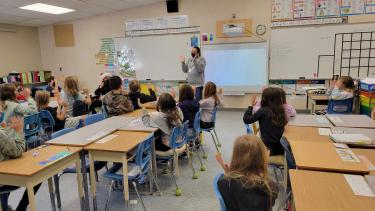
Practical Ways to Integrate Indigenous Worldviews Through Literacy: A Tale of Two Teachers
At Sandy Hill, Krissy Rodriguez, Grade 5 French Immersion and Teresa Seo, Grade 5 English, have been collaborating on different ways of practically incorporating Indigenous worldviews through literacy. With the support of their Indigenous Support Worker, Jessie Old Coyote, Indigenous Helping Teachers, Allison Gardner and Loraleigh Epp, Modern Languages Helping Teacher, Natalie DeWit and the resources at the Ray and Millie Silver Library, they were able to begin to practically apply Indigenous worldviews through literacy. Here are the tales of two teachers.
Krissy’s Story
I was inspired by Indigenous education and literacy this year and was looking for a way to integrate the two. I didn’t know exactly what I was looking for, and I encountered some hurdles in my library exploration. In the French stories, the register of language and vocabulary was far out of reach for independent or small group reading, a familiar challenge in French Immersion! In English, I figured out that I was looking for diversity in the elements of the stories and didn’t know where to find it. The invaluable collaboration and pro-d that followed helped turn a complicated challenge into something attainable: simple variations on literacy circles.
In French, our Literature Circle is done as a class, and looks like a novel study. “Je ne suis pas un numéro” by Jenny Kay Dupuis and Kathy Kacer, illustrated by Gillian Newland, is about Dupuis’ own grandmother and her experience in residential school. In English, our Literature Circle is done in oral tradition format, with Jessi Old Coyote telling us The Mosquito Story from the Sto:lo sitel. Oral traditions teach that you get something different from the story each time. We work on the same reading comprehension skill in both languages at the same time, using different mediums to deepen understanding. Moving forward, I will be using the engaging novel choices at the Ray and Millie Silver library that are available to take out as small sets for Literature Circles and will continue to look for French books that are just-right for a whole class novel study.
I have greatly appreciated the time with amazing colleagues who have helped make this into an integrated Indigenous literacy project. I love that student learning is happening with their good hearts and good minds. Their learning has shown measurable success and I am proud to work with all the wonderful people that have been a part of this project.
Teresa’s Story
When Krissy first approached me in the fall with the idea of incorporating Indigenous worldviews through literacy, my mind started racing at all the possibilities. Initially, it seemed a bit daunting as to how this was all going to play out, but as we took time to visit the Ray and Millie Silver Library together and begin to have conversations with our Indigenous Support Worker and Indigenous Helping Teacher, the whole process seemed to unfold naturally. Here is what I learned:
- Start with the First Peoples’ Principals of Learning (FPPL) website (https://firstpeoplesprinciplesoflearning.wordpress.com), which is an amazing resource. It was here that I realized that I was already incorporating some of these principles in my everyday teaching. Whether it was utilizing stories and history to enrich student learning or enabling students to discover their identity through family interviews or even simply helping students to learn responsibility and accountability through intended or unintended consequences of everyday actions, these were all part of the FPPL.
- Secondly, take the time to have conversations with the resourceful people around you. After taking the time to talk with our Indigenous Support worker, Jessie Old Coyote, and attending Indigenous workshops by Allison Gardner, I felt more equipped as a teacher to integrate more Indigenous content in my teaching, especially through literacy. The learning that occurred through these workshops and conversations and how the learning continued to flow in my own classroom through my students exemplified, not only the FPPL in action, but also the incredible learning that can occur from each other. An example of this was through our Natural Resources Unit and the focus on the history of Sumas Lake and its role as a natural resource to the Indigenous people. Using resources from The Reach Gallery and resources from the workshop, students were able to discover the impact of Sumas Lake and the historical significance for the Indigenous people. This learning was even more applicable with the recent flooding that occurred in Sumas Prairie.
- Lastly, be intentional about using Indigenous books in your classroom. As part of my read-aloud this year, I chose to read the book, Barren Grounds by David Robertson. This book has been a great tool for my students to apply their reading comprehension skills as well as learn and pique curiosity about Indigenous ways of life. While I am still learning and growing as a teacher, it has been amazing this year to be able to collaborate with my colleague and discover practical ways to integrate Indigenous worldviews through literacy.